Gingerbread Cake Recipe: Your Essential Guide to a Moist and Flavorful Holiday Classic
There’s nothing quite like the aroma and taste of a perfectly baked gingerbread cake to usher in the holiday season. This ultimate gingerbread cake recipe promises a cake that is incredibly moist, rich, and bursting with the festive flavors of the season. Forget dry, crumbly cakes; this old-fashioned recipe delivers a tender crumb and deep, aromatic spice that will become a cherished part of your holiday traditions. Get ready to bake this truly special treat today!
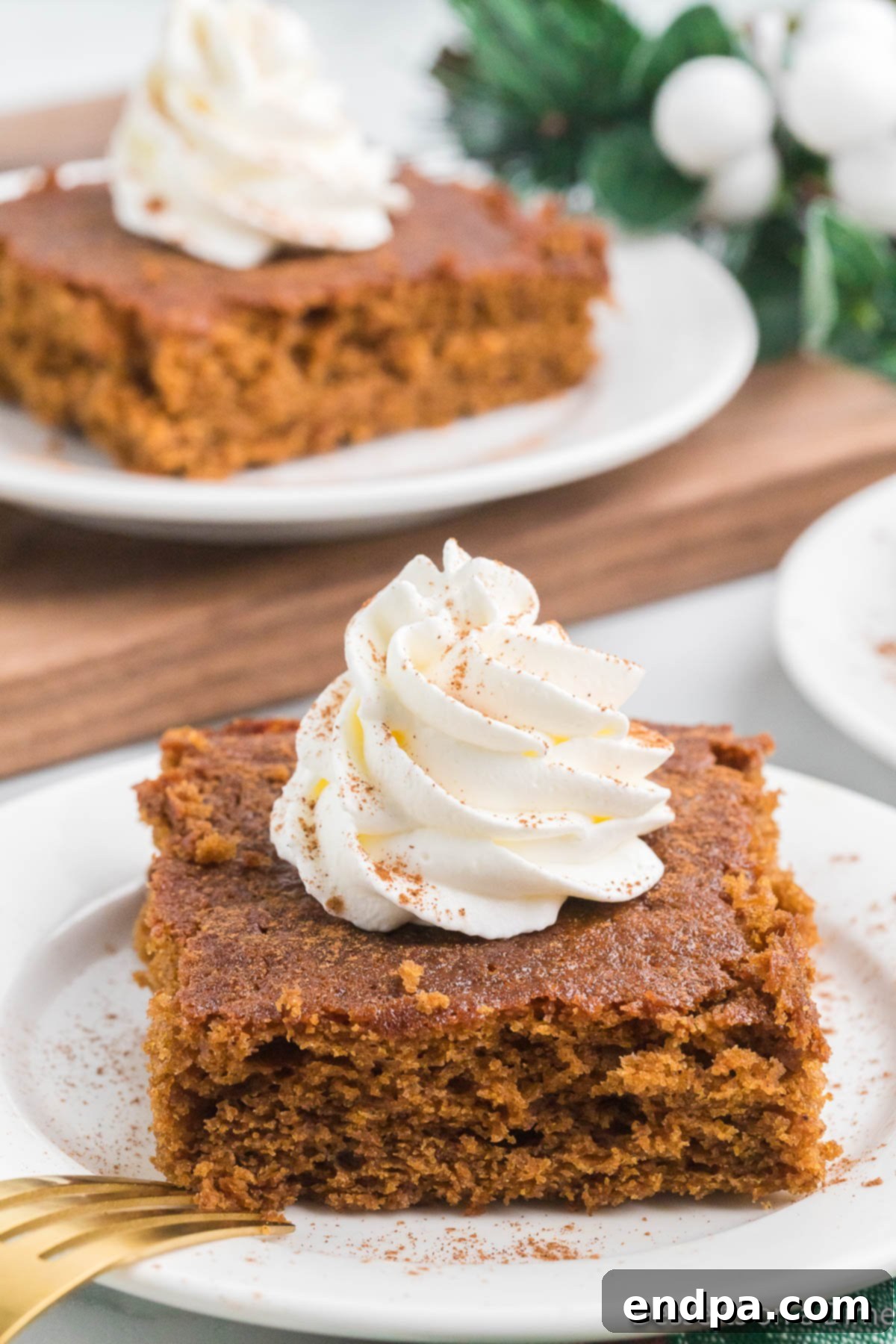
Gingerbread evokes a sense of warmth, coziness, and cherished holiday memories. Beyond this incredible cake, we adore exploring various gingerbread delights throughout the festive season. From building whimsical gingerbread houses with the family to indulging in these soft gingerbread cookies and the wonderfully chewy ginger molasses cookies, the spiced flavor profile is simply irresistible.
The harmonious blend of pungent ginger, warm cinnamon, sweet nutmeg, and a hint of clove comes together to create a symphony of flavors that define this magnificent cake. Each bite is a journey into holiday cheer. As you plan your festive baking, be sure to explore all of our delightful Christmas Dessert Recipes for more inspiration. Another beloved holiday activity that perfectly complements this cake is creating your own Gingerbread House – a fun project for all ages!
What’s in this Post: Your Guide to Gingerbread Cake
- Why You’ll Adore This Gingerbread Cake
- Gingerbread vs. Ginger Cake: Understanding the Difference
- Essential Ingredients for Your Gingerbread Cake
- Creative Substitutions and Delicious Additions
- Step-by-Step Instructions: Baking Your Perfect Cake
- Expert Tips for Gingerbread Cake Perfection
- Frosting Options for Your Gingerbread Cake
- Transforming Your Cake into Gingerbread Cupcakes
- Troubleshooting: Why Your Gingerbread Cake Might Be Dry
- Freezing Gingerbread Cake for Future Enjoyment
- Storing Your Gingerbread Cake for Optimal Freshness
- More Easy and Delicious Cake Recipes to Try
- Full Gingerbread Cake Recipe Card
Why You’ll Adore This Gingerbread Cake: The Perfect Holiday Indulgence
This isn’t just another cake recipe; it’s an experience that embodies the very essence of the holidays. Here’s why this gingerbread cake will quickly become a treasured favorite:
- Unmatched Moisture and Flavor: The Best Holiday Cake – Crafted to be incredibly moist, tender, and intensely flavorful, this gingerbread cake truly stands out as the ultimate holiday dessert. Its rich, deep spice profile, perfectly balanced with the sweetness of molasses, creates a comforting and festive taste that is simply irresistible. It’s the kind of cake that makes everyone feel like it’s Christmas morning, no matter when you serve it.
- Effortless Preparation for Busy Seasons – Despite its impressive taste and appearance, this cake is surprisingly easy to prepare. The entire mixing process takes less than 15 minutes, making it a fantastic last-minute dessert option during the often-hectic holiday season. Spend less time in the kitchen and more time enjoying the festivities with your loved ones.
- Versatile Serving Options: Frosting or No Frosting – The inherent depth of flavor in this gingerbread cake is so satisfying that it can be beautifully served without any elaborate frosting. A simple dusting of powdered sugar adds an elegant touch, or you can elevate it further with a dollop of fresh whipped cream. However, if you desire a more decadent experience, it provides an excellent canvas for various frostings, offering endless possibilities for customization.
- Perfect for Any Occasion – Whether you’re looking for a delightful afternoon snack, a show-stopping dessert for a holiday feast, or a comforting treat to pair with your morning coffee, this gingerbread cake fits every bill. Its robust flavor stands up well to warm beverages, making it a wonderful companion for cozy moments by the fireplace.
Gingerbread vs. Ginger Cake: Understanding the Delicious Nuances
While often used interchangeably, there’s a subtle yet distinct difference between a traditional gingerbread recipe and a generic ginger cake, primarily rooted in their ingredient profiles and resulting flavor complexities. An old-fashioned gingerbread cake, like the one we’re making, is characterized by a medley of warm, potent spices such as ground ginger, cinnamon, cloves, and sometimes nutmeg or allspice. Crucially, it always features molasses, which imparts its signature dark color, moist texture, and unique, slightly bittersweet depth of flavor. Molasses is key to the authentic “gingerbread” taste.
On the other hand, a “ginger cake” typically relies more heavily on ginger as its primary flavor, often omitting molasses or using it in much smaller quantities. This usually results in a lighter colored cake with a more singular ginger spice note, and often a less dense, less intensely moist texture. While still delicious, ginger cake often lacks the dark, rich complexity and chewy moistness that molasses brings to a classic gingerbread. Our recipe embraces the full, traditional gingerbread character for that truly authentic holiday feel.
Essential Ingredients for Your Ultimate Gingerbread Cake
Crafting this moist and flavorful gingerbread cake requires a selection of pantry staples and aromatic spices. Here’s what you’ll need to gather:

- All-purpose Flour: The foundation of our cake’s structure.
- Baking Powder: A leavening agent that helps the cake rise and achieve its tender texture.
- Baking Soda: Works with the acidic buttermilk and molasses to ensure a light and airy crumb.
- Salt: Balances the sweetness and enhances all the flavors.
- Ground Ginger: The star spice, providing that signature warmth and gentle heat.
- Ground Cinnamon: Adds a sweet and woody aroma that complements the ginger beautifully.
- Ground Nutmeg: Offers a warm, slightly nutty undertone that enriches the spice blend.
- Ground Cloves: Contributes a strong, sweet, and pungent note, essential for classic gingerbread flavor.
- Unsalted Butter, softened: Provides richness and helps create a tender, moist cake. Ensure it’s truly softened for best creaming results.
- Molasses: This dark, syrupy ingredient is non-negotiable for authentic gingerbread. It provides deep color, intense moisture, and a distinct bittersweet flavor. We recommend using regular or robust molasses for the best flavor.
- Granulated Sugar: Sweetens the cake and aids in tenderizing the crumb.
- Large Egg, room temperature: Acts as a binder and adds richness and moisture. Room temperature eggs emulsify better with other ingredients.
- Buttermilk: Contributes to the cake’s moistness and activates the baking soda, creating a tender crumb. Don’t have any? Learn what is buttermilk and how to make a quick substitute!
- Whipped Cream for serving (if desired): A light, airy counterpoint to the rich cake.
- Powdered Sugar, for dusting (if desired): A simple and elegant garnish.
For a detailed breakdown of measurements and comprehensive recipe instructions, please scroll down to the full recipe card at the bottom of this post.
Creative Substitutions and Delicious Additions to Personalize Your Cake
This gingerbread cake is wonderful as is, but it’s also incredibly versatile! Feel free to experiment with these ideas to make it uniquely yours:
- Nuts for Extra Crunch and Flavor – Adding nuts can introduce a delightful crunch and nutty depth to your cake. Consider folding in chopped walnuts, pecans, almonds, or even cashews into the batter. For an extra touch, you can also sprinkle them on top of the cake before baking, or even press them into the frosting for a beautiful garnish. Toasting the nuts lightly before adding them can enhance their flavor.
- Gluten-Free Options – If you’re catering to dietary restrictions, this recipe can easily be adapted. Simply substitute the all-purpose flour with a high-quality 1:1 gluten-free baking flour blend. Most blends are designed to replace regular flour cup-for-cup without significant changes to liquid content, but always check the specific brand’s recommendations for best results.
- Stir in Dried Fruit for a Festive Twist – For an even richer, more complex holiday flavor, incorporate dried fruits into your batter. Excellent choices include diced dried apples, plump cranberries, sweet raisins, tangy chopped dried oranges, or even finely chopped dried pineapple. For best results, you might want to soak raisins or cranberries in warm water or a little rum for about 15-20 minutes before adding them to the batter; this helps them plump up and distribute more evenly without sinking.
- Alternative Sweeteners: Brown Sugar – While our recipe calls for granulated sugar, using light or dark brown sugar can add an even deeper, more caramel-like flavor to your gingerbread. Dark brown sugar will intensify the molasses notes and result in an even moister cake. If substituting, you can often do so cup-for-cup, but be aware of the slight change in flavor and moisture profile.
- Citrus Zest for Brightness – A tablespoon or two of fresh orange or lemon zest can brighten the deep spice flavors, adding an unexpected lift to the cake.
- Candied Ginger – For an extra kick of ginger and a delightful chew, finely chop some candied ginger and fold it into the batter.
Step-by-Step Instructions: Baking Your Perfect Gingerbread Cake
Follow these detailed steps to ensure your gingerbread cake comes out moist, fragrant, and absolutely perfect every time:
- Step 1: Preheat Your Oven – Begin by preheating your oven to 350 degrees F (175 degrees C). Accurate oven temperature is crucial for even baking, so if you have an oven thermometer, now is a great time to use it.
- Step 2: Prepare Your Baking Pan – Generously spray a 13×9 inch baking pan with a non-stick cooking spray, then lightly dust it with all-purpose flour. Tap out any excess flour. This prevents the cake from sticking and ensures a clean release. Alternatively, you can line the bottom of the pan with parchment paper and then spray and flour the sides.
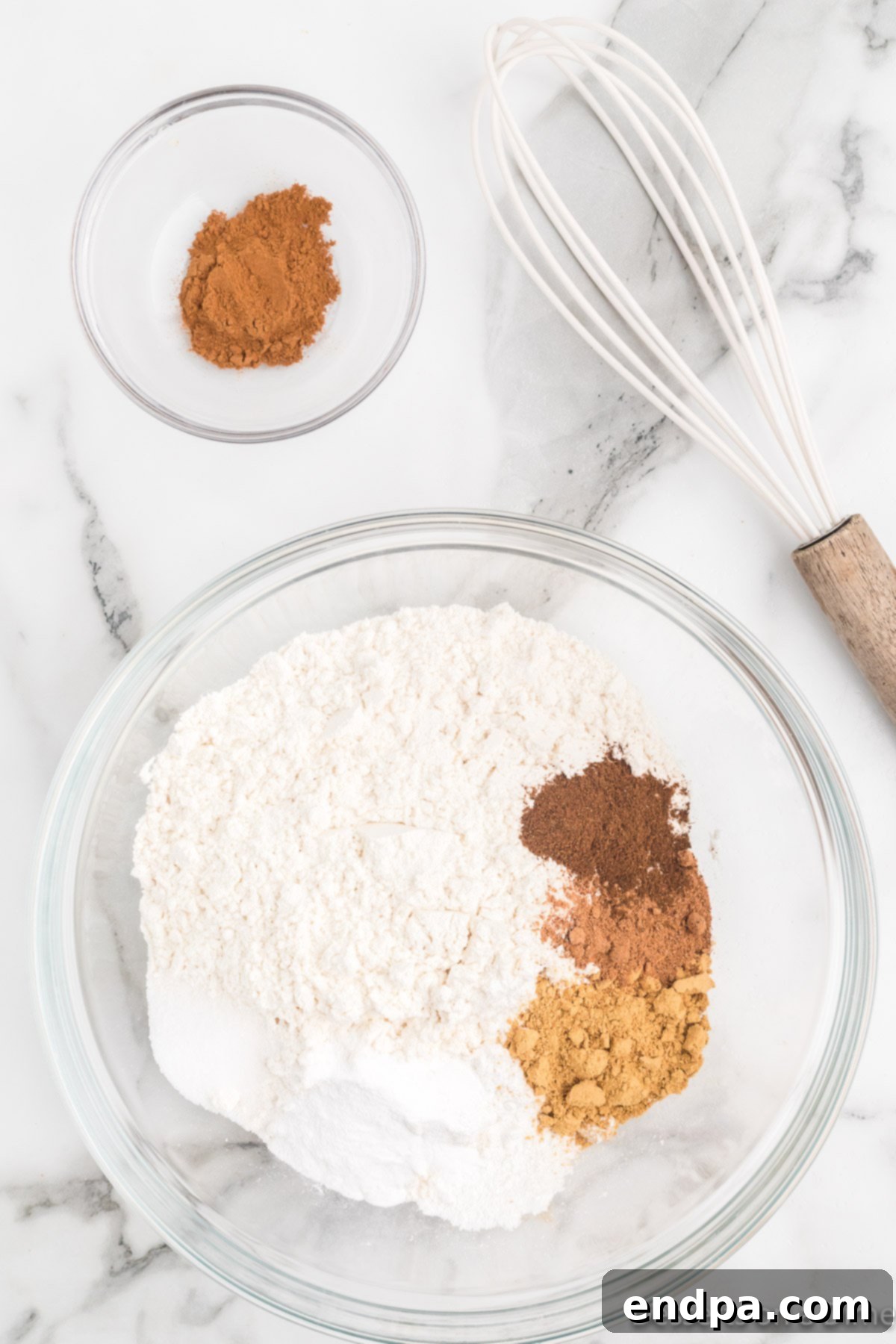
Step 3: Combine Dry Ingredients – In a medium-sized bowl, whisk together the all-purpose flour, baking soda, baking powder, salt, ground ginger, ground cinnamon, ground nutmeg, and ground cloves. Whisking thoroughly ensures that the leavening agents and spices are evenly distributed throughout the batter, leading to consistent flavor and rise.

Step 4: Cream Wet Ingredients – In a separate large mixing bowl, using an electric mixer, cream together the softened unsalted butter and granulated sugar until the mixture is light, fluffy, and pale in color. This step incorporates air, which contributes to the cake’s tender texture. Then, beat in the room temperature large egg and the molasses until well combined and smooth. Ensure there are no lumps of butter or sugar remaining.

Step 5: Alternate Dry and Wet Additions – Gradually add the dry ingredient mixture to the wet ingredients, alternating with the buttermilk. Start and end with the dry ingredients. For example, add about a third of the dry mix, beat until just combined, then add half the buttermilk, beat, then another third of dry mix, beat, the remaining buttermilk, beat, and finally the last third of dry mix. After each addition, beat only until just incorporated, scraping down the sides and bottom of the bowl as needed to ensure everything is well mixed without overmixing. Overmixing can lead to a tough cake.
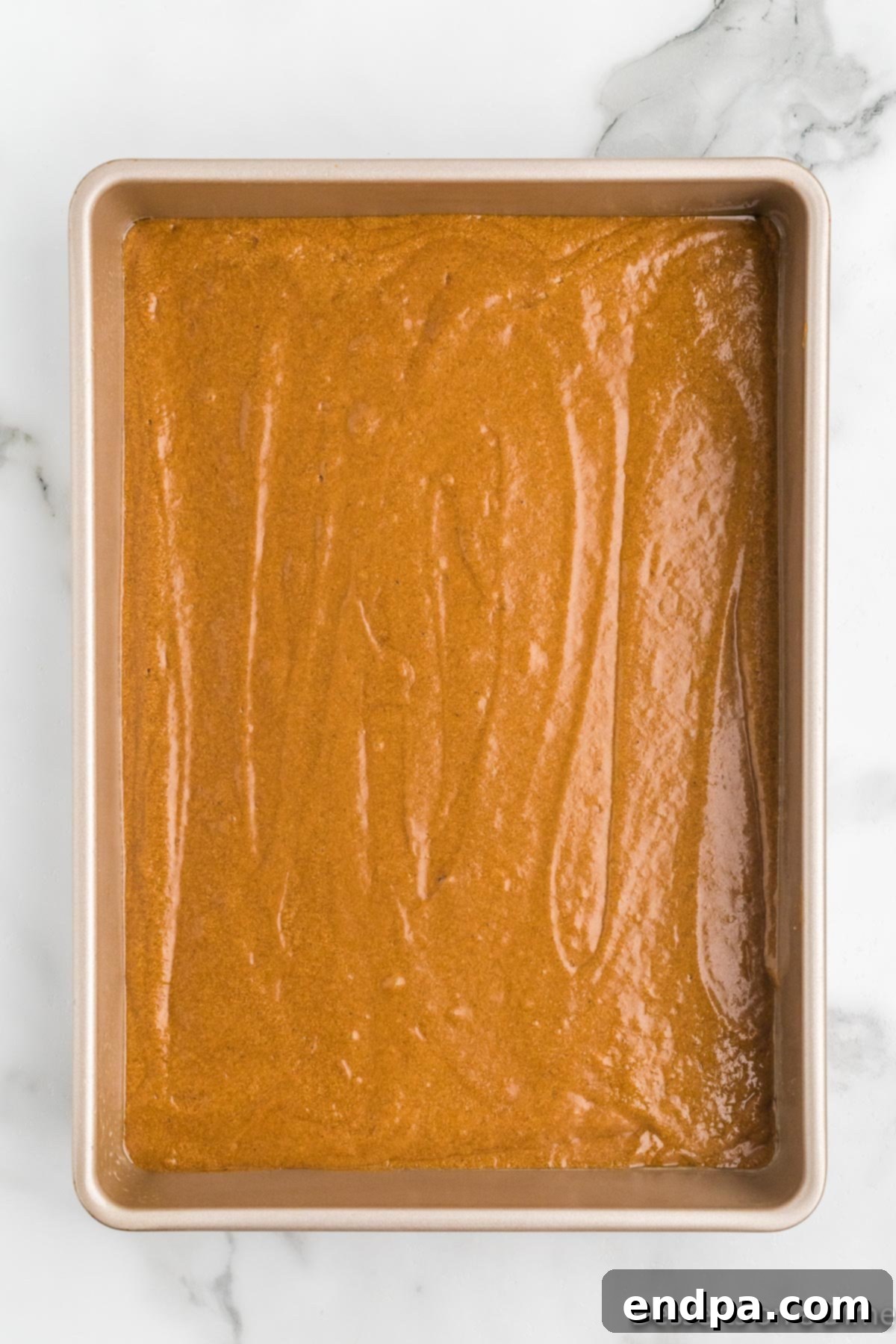
Step 6: Bake to Perfection – Pour the prepared batter evenly into your greased and floured baking pan. Transfer to the preheated oven and bake for 40-45 minutes. The cake is done when a wooden toothpick inserted into the center comes out clean or with a few moist crumbs attached. Be mindful that baking times can vary based on individual ovens and the specific pan material; avoid overbaking to maintain that desired moist texture. Once baked, let the cake cool in the pan on a wire rack for about 10-15 minutes before inverting it onto the rack to cool completely. Another fantastic option is to bake this recipe in a bundt cake pan for a beautiful presentation, though baking time may need slight adjustment (usually around 50-60 minutes). Always use the toothpick test for doneness.
Expert Tips for Gingerbread Cake Perfection
Achieving the perfect moist and flavorful gingerbread cake is easy with these insider tips:
- Adjusting Spice Levels to Your Preference – The spice quantities in this recipe provide a beautifully balanced and aromatic flavor profile. However, if you prefer a gingerbread cake with a bolder, more pronounced “spicy” kick, don’t hesitate to increase the amounts of ground ginger, cloves, or cinnamon by an additional ¼ to ½ teaspoon each. You can also add a pinch of black pepper or white pepper for an unexpected warmth that truly elevates the spice blend. Always use fresh, good-quality spices for the best aroma and flavor.
- Ensuring Perfect Doneness Without Overbaking – The key to a moist cake is knowing when it’s perfectly baked. Use the toothpick test: insert a wooden toothpick into the center of the cake. If it comes out clean or with a few moist crumbs attached, your cake is done. If it’s wet with batter, continue baking for a few more minutes and retest. Overbaking is the primary culprit behind dry cakes, so keep a close eye on it, especially during the last 10-15 minutes of baking.
- The Role of Molasses: Choosing Your Flavor Profile – Molasses is indispensable for an authentic gingerbread cake. You can choose between regular (light) molasses for a milder, sweeter flavor or robust (dark) molasses for a deeper, more pronounced bittersweet taste and darker color. Blackstrap molasses is the most intense and less sweet, often used for very strong ginger flavors; use it sparingly or mix it with regular molasses if you want to try it. Your choice of molasses will significantly influence the final flavor and appearance of your cake.
- Room Temperature Ingredients for Optimal Texture – For the best results, always ensure your unsalted butter and large egg are at room temperature before you begin mixing. Room temperature butter creams more smoothly with sugar, incorporating more air for a lighter cake. Room temperature eggs emulsify better into the batter, preventing curdling and leading to a more uniform, tender crumb. Plan ahead and take them out of the refrigerator at least 30-60 minutes before you start baking.
- Accurate Flour Measurement – Measuring flour correctly is crucial. Too much flour can lead to a dry, dense cake. Spoon the flour into your measuring cup and then level it off with a straight edge (like the back of a knife) rather than scooping directly from the bag, which can compact the flour and result in using more than needed.
- Don’t Overmix the Batter – Once you add the flour mixture, mix only until the ingredients are just combined. Overmixing develops the gluten in the flour, which can make your cake tough and chewy instead of tender and moist.
- Cooling Your Cake Properly – Allow your cake to cool completely on a wire rack before attempting to frost or slice it, especially if you plan to add a thick layer of frosting. This prevents the cake from crumbling and ensures the frosting doesn’t melt.
Frosting Options for Your Gingerbread Cake: Simple to Decadent
One of the beauties of this gingerbread cake is its versatility when it comes to toppings. While the cake is rich and flavorful enough to stand on its own, here are a few ideas to elevate your serving:
- Simple Powdered Sugar Dusting – For a classic, understated elegance that lets the cake’s natural flavors shine, simply dust the cooled cake generously with powdered sugar (confectioners’ sugar) using a fine-mesh sieve. This creates a beautiful, snowy effect perfect for the holidays.
- Light and Airy Whipped Cream – A dollop of freshly homemade whipped cream is an exquisite pairing. Its light, airy texture and delicate sweetness provide a perfect contrast to the dense, spiced cake. You can even add a touch of vanilla extract or a pinch of cinnamon to your whipped cream for extra flavor.
- Rich Cream Cheese Frosting – If you’re craving a more traditional and decadent frosting, a tangy and sweet Cream Cheese Frosting is an excellent choice. Its creamy texture and slight tartness wonderfully complement the rich spices of the gingerbread. Our simple recipe typically includes cream cheese, butter, powdered sugar, and vanilla extract, making it incredibly easy to whip up your own homemade frosting.
- Lemon Glaze – For a bright, zingy contrast, a simple lemon glaze made from powdered sugar and fresh lemon juice can be drizzled over the cooled cake.
Transforming Your Gingerbread Cake into Festive Cupcakes
Absolutely! This versatile gingerbread cake recipe can easily be adapted to make delicious individual cupcakes, perfect for parties, lunchboxes, or portion control. The process is straightforward:
- Prepare Your Muffin Pan – Line a standard 12-cup muffin pan with festive paper cupcake liners, or generously spray each well with nonstick cooking spray if you prefer to go liner-free.
- Fill the Liners – Using an ice cream scoop or spoon, fill each muffin cup about two-thirds of the way full with the gingerbread cake batter. Avoid overfilling, as this can cause the cupcakes to spill over the top while baking.
- Baking Time – Bake the cupcakes in your preheated 350°F (175°C) oven for approximately 18 to 25 minutes. Baking time will be significantly shorter than for a full cake. Start checking for doneness around 18 minutes by inserting a toothpick into the center of a cupcake; it should come out clean.
- Cooling and Decorating – Once baked, remove the cupcakes from the oven and let them cool in the muffin pan for a few minutes before transferring them to a wire rack to cool completely. Once cooled, you can frost them with cream cheese frosting, dust them with powdered sugar, or top them with whipped cream, just like the cake!
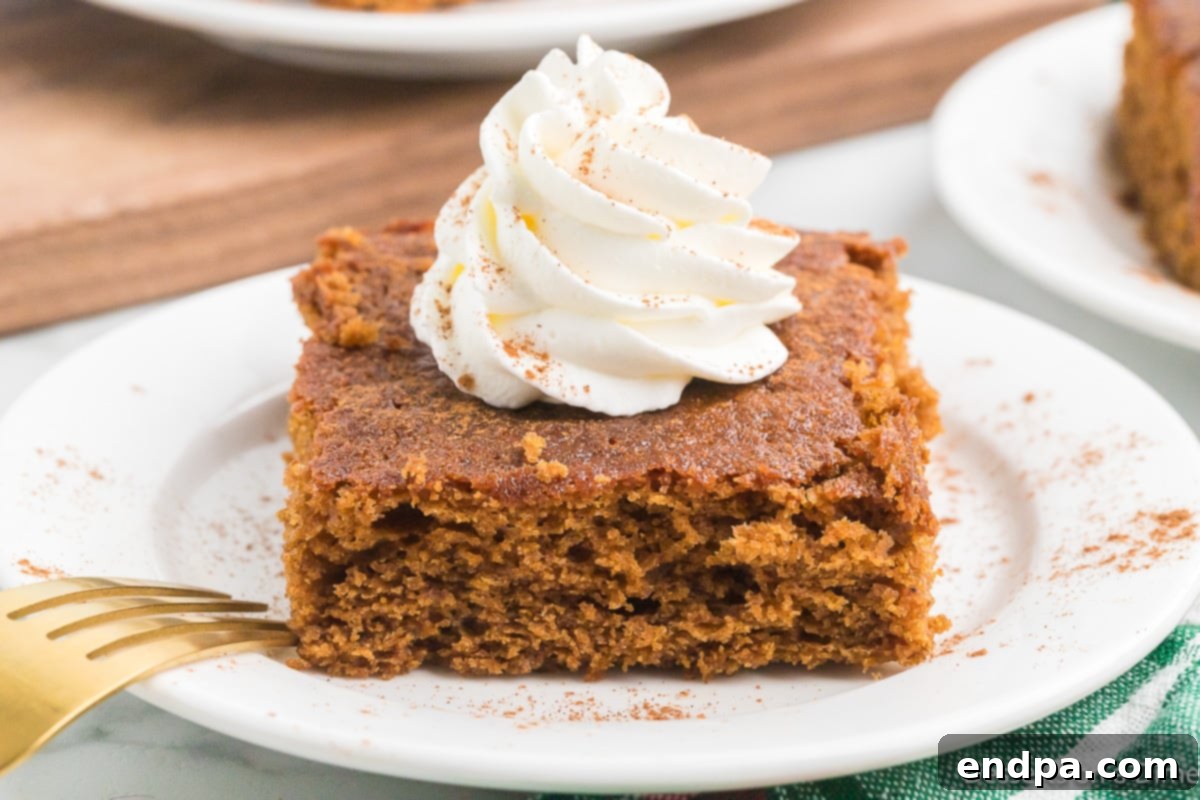
Troubleshooting: Why Your Gingerbread Cake Might Be Dry
If your gingerbread cake turns out dry, don’t despair! This is a common baking challenge, and there are several reasons why it might happen. Understanding the causes can help you prevent it in the future:
- Incorrect Oven Temperature – One of the most frequent culprits is an oven that runs too hot. An oven that’s too high can cause the cake to bake too quickly on the outside, drying it out before the inside is properly cooked. You might notice the edges are burnt while the center is undercooked, or the entire cake is simply overbaked and dry. We highly recommend using an inexpensive oven thermometer to verify your oven’s true temperature, as many home ovens can be off by 25-50 degrees F. An oven that’s too hot can also contribute to the cake sinking in the middle due to rapid rising and then collapsing.
- Overbaking – Even if your oven temperature is accurate, baking the cake for too long will inevitably lead to a dry result. Keep a close eye on the baking time and rely on the toothpick test as your primary indicator of doneness. As soon as the toothpick comes out clean or with moist crumbs, remove the cake from the oven. Remember, cakes continue to cook slightly from residual heat after being removed from the oven.
- Improper Ingredient Measurement – The ratio of wet to dry ingredients is crucial for a moist cake. Adding too much flour is a common mistake that can significantly dry out your cake. Be sure to measure your flour accurately by spooning it into the measuring cup and leveling it off, rather than scooping directly, which can compact the flour. Similarly, incorrect amounts of liquids (molasses, buttermilk) can affect moisture.
- Not Using Room Temperature Ingredients – As mentioned in our expert tips, using cold butter and eggs can prevent proper emulsification, leading to a less cohesive batter and potentially a drier, denser cake.

Freezing Gingerbread Cake for Future Enjoyment
Yes, gingerbread cake freezes beautifully, making it an ideal make-ahead dessert for busy holiday seasons or for enjoying a taste of Christmas any time of year! Properly stored, your gingerbread cake can maintain its delicious quality in the freezer for up to 2 months.
- How to Freeze – Allow the cake to cool completely to room temperature before freezing. If the cake is frosted, make sure the frosting is firm before wrapping. For best results, wrap the entire cake or individual slices tightly in several layers of plastic wrap, ensuring no air is exposed to prevent freezer burn. Then, place the plastic-wrapped cake into a freezer-safe airtight container or a heavy-duty zip-top freezer bag. Label with the date.
- Thawing Instructions – When you’re ready to enjoy, transfer the frozen cake (still wrapped) to the refrigerator and allow it to thaw slowly overnight. This gradual thawing helps to preserve moisture. If thawing individual slices, they may thaw more quickly at room temperature for an hour or two. Once thawed, you can serve it chilled, at room temperature, or even gently warmed in the microwave for a fresh-baked feel.
Freezing this cake ahead of time is a brilliant strategy to save precious time amidst all the other holiday baking and preparations, allowing you to focus on enjoying the season.
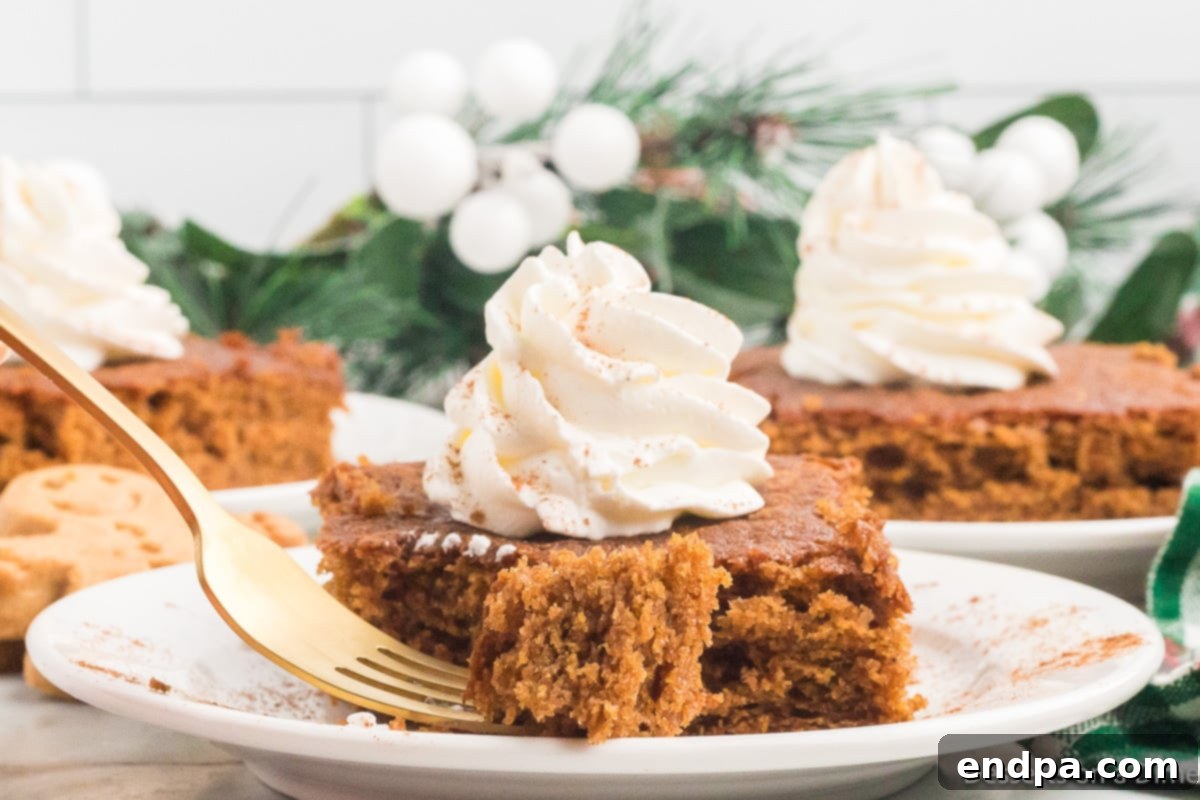
Storing Your Gingerbread Cake for Optimal Freshness
To keep your gingerbread cake tasting its best and maintaining its wonderful moisture, proper storage is essential. Here’s how to store it:
- At Room Temperature – We recommend storing unfrosted gingerbread cake at room temperature. Once the cake has cooled completely, cover it tightly with plastic wrap or place it in an airtight container. Stored this way, it will remain fresh, moist, and delicious for up to 5 days. If the cake is frosted with cream cheese frosting, it should be stored in the refrigerator due to the dairy content.
- In the Refrigerator (for frosted cakes) – If your cake has a dairy-based frosting (like cream cheese frosting or whipped cream), it should be stored in the refrigerator. Cover it loosely with plastic wrap or place it in a cake carrier. Bring it to room temperature for about 30 minutes before serving for the best flavor and texture.
More Easy and Delicious Cake Recipes to Try
If you’ve enjoyed baking this gingerbread cake, you’ll love exploring more of our simple and delightful cake recipes, perfect for any occasion:
- Christmas Tree Cupcakes Recipe
- Christmas Jello Poke Cake Recipe
- Dirt Cake Christmas Recipe
- Hummingbird Cake
- Pineapple Upside Down Cake with Cake Mix
- Chocolate Chip Cookie Cake Recipe
We absolutely love hearing from you! If you make this wonderfully easy and flavorful gingerbread cake recipe, please don’t hesitate to leave a comment below or give it a star review. Your feedback helps us and other bakers!
Classic Gingerbread Cake Recipe
15 mins
45 mins
1 hr
12
American
Dessert
278
Carrie Barnard
Ingredients
- 2 cups all-purpose flour
- 1 teaspoon baking powder
- 1 teaspoon baking soda
- ½ teaspoon salt
- 2 teaspoon ground ginger
- 1 teaspoon ground cinnamon
- 1 teaspoon ground nutmeg
- ½ teaspoon ground cloves
- ½ cup 1 stick unsalted butter, softened
- ½ cup granulated sugar
- 1 cup molasses
- 1 egg room temperature
- 1 cup buttermilk
- Whipped cream for serving if desired
- Powdered sugar for dusting if desired
Instructions
- Preheat oven to 350 degrees F (175 C).
- Spray a 13×9 inch baking dish with cooking spray and lightly dust with flour, tapping out excess.
- In a medium bowl, whisk together the flour, baking powder, baking soda, salt, and all spices until well combined.
- In a large bowl, using an electric mixer, cream together the softened butter and granulated sugar until light and fluffy.
- Beat in the room temperature egg and molasses until fully incorporated.
- Gradually add the dry ingredient mixture to the wet, alternating with the buttermilk. Begin and end with the dry ingredients, beating after each addition just until combined and scraping down the sides of the bowl as needed. Do not overmix.
- Spread the batter evenly into your prepared baking dish.
- Bake for 40-45 minutes, or until a wooden toothpick inserted into the center comes out clean.
- Allow the cake to cool in the pan on a wire rack for about 10-15 minutes, then invert onto the rack to cool completely to room temperature. Serve warm or cooled, optionally with whipped cream or a dusting of powdered sugar.
- Store any leftovers in an airtight container to maintain freshness.
Nutrition Facts
Calories
278kcal
,
Carbohydrates
47g
,
Protein
3g
,
Fat
9g
,
Saturated Fat
5g
,
Cholesterol
36mg
,
Sodium
293mg
,
Potassium
504mg
,
Fiber
1g
,
Sugar
30g
,
Vitamin A
289IU
,
Calcium
104mg
,
Iron
2mg
